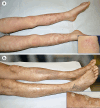Cross-Sectional Study on Autosomal Recessive Congenital Ichthyoses: Association of Genotype with Disease Severity, Phenotypic, and Ultrastructural Features in 74 Italian Patients
- PMID: 38588653
- PMCID: PMC11168449
- DOI: 10.1159/000536366
Cross-Sectional Study on Autosomal Recessive Congenital Ichthyoses: Association of Genotype with Disease Severity, Phenotypic, and Ultrastructural Features in 74 Italian Patients
Abstract
Background: Autosomal recessive congenital ichthyoses (ARCIs) are a clinically heterogeneous group of keratinization disorders characterized by generalized skin scaling due to mutations in at least 12 genes. The aim of our study was to assess disease severity, phenotypic, and ultrastructural features and to evaluate their association with genetic findings in ARCI patients.
Methods: Clinical signs and symptoms, and disease severity were scored in a single-center series of patients with a genetic diagnosis of ARCI. Skin ultrastructural findings were reviewed.
Results: Seventy-four consecutive patients (mean age 11.0 years, range 0.1-48.8) affected with lamellar ichthyosis (50/74, 67.5%), congenital ichthyosiform erythroderma (18/74, 24.3%), harlequin ichthyosis (two/74, 2.7%), and other minor ARCI subtypes (four/74, 5.4%) were enrolled. Mutated genes were as follows: TGM1 in 18/74 (24.3%) patients, ALOX12B in 18/74 (24.3%), CYP4F22 in 12/74 (16.2%), ABCA12 in nine/74 (12.2%), ALOXE3 in seven/74 (9.5%), NIPAL4 in seven/74 (9.5%), and CERS3, PNPLA1, and SDR9C7 in 1 patient each (1.4%). Twenty-five previously undescribed mutations in the different ARCI causative genes, as well as two microduplications in TGM1, and two microdeletions in CYP4F22 and NIPAL4 were identified. The mean ichthyosis severity score in TGM1- and ABCA12-mutated patients was significantly higher than in all other mutated genes, while the lowest score was observed in CYP4F22-mutated patients. Alopecia, ectropion, and eclabium were significantly associated with TGM1 and ABCA12 mutations, and large, thick, and brownish scales with TGM1 mutations. Among specific phenotypic features, psoriasis-like lesions as well as a trunk reticulate scale pattern and striated keratoderma were present in NIPAL4-mutated patients. Ultrastructural data available for 56 patients showed a 100% specificity of cholesterol clefts for TGM1-mutated cases and revealed abnormal lamellar bodies in SDR9C7 and CERS3 patients.
Conclusion: Our study expands the phenotypic and genetic characterization of ARCI by the description of statistically significant associations between disease severity, specific clinical signs, and different mutated genes. Finally, we highlighted the presence of psoriasis-like lesions in NIPAL4-ARCI patients as a novel phenotypic feature with diagnostic and possible therapeutic implications.
Keywords: Collodion baby; Congenital ichthyosiform erythroderma; Electron microscopy; Lamellar ichthyosis; Next-generation sequencing.
© 2024 The Author(s). Published by S. Karger AG, Basel.
Conflict of interest statement
The authors have no conflicts of interest to declare.
Figures




Similar articles
-
Update on autosomal recessive congenital ichthyosis: mRNA analysis using hair samples is a powerful tool for genetic diagnosis.J Dermatol Sci. 2015 Jul;79(1):4-9. doi: 10.1016/j.jdermsci.2015.04.009. Epub 2015 Apr 30. J Dermatol Sci. 2015. PMID: 25982146 Review.
-
Mutational Spectrum of the ABCA12 Gene and Genotype-Phenotype Correlation in a Cohort of 64 Patients with Autosomal Recessive Congenital Ichthyosis.Genes (Basel). 2023 Mar 15;14(3):717. doi: 10.3390/genes14030717. Genes (Basel). 2023. PMID: 36980989 Free PMC article.
-
Genotype-phenotype correlation in a large English cohort of patients with autosomal recessive ichthyosis.Br J Dermatol. 2020 Mar;182(3):729-737. doi: 10.1111/bjd.18211. Epub 2019 Aug 26. Br J Dermatol. 2020. PMID: 31168818
-
Genotype of autosomal recessive congenital ichthyosis from a tertiary care center in India.Pediatr Dermatol. 2022 May;39(3):420-424. doi: 10.1111/pde.14944. Epub 2022 Apr 12. Pediatr Dermatol. 2022. PMID: 35412663
-
Harlequin ichthyosis and other autosomal recessive congenital ichthyoses: the underlying genetic defects and pathomechanisms.J Dermatol Sci. 2006 May;42(2):83-9. doi: 10.1016/j.jdermsci.2006.01.003. Epub 2006 Feb 14. J Dermatol Sci. 2006. PMID: 16481150 Review.
Cited by
-
Comprehensive Molecular Analysis of Disease-Related Genes as First-Tier Test for Early Diagnosis, Classification, and Management of Patients Affected by Nonsyndromic Ichthyosis.Biomedicines. 2024 May 17;12(5):1112. doi: 10.3390/biomedicines12051112. Biomedicines. 2024. PMID: 38791074 Free PMC article.
References
-
- Oji V, Tadini G, Akiyama M, Blanchet Bardon C, Bodemer C, Bourrat E, et al. . Revised nomenclature and classification of inherited ichthyoses: results of the first ichthyosis consensus conference in sorèze 2009. J Am Acad Dermatol. 2010;63(4):607–41. - PubMed
-
- Rajpopat S, Moss C, Mellerio J, Vahlquist A, Gånemo A, Hellstrom-Pigg M, et al. . Harlequin ichthyosis: a review of clinical and molecular findings in 45 cases. Arch Dermatol. 2011;147(6):681–6. - PubMed
-
- Glick JB, Craiglow BG, Choate KA, Kato H, Fleming RE, Siegfried E, et al. . Improved management of harlequin ichthyosis with advances in neonatal intensive care. Pediatrics. 2017;139(1):e20161003. - PubMed
-
- De Palma AM, Mazereeuw-Hautier J, Giehl K, Hernández-Martin A, Merlos M, Moons P, et al. . Burden of itch in ichthyosis: a multicentre study in 94 patients. J Eur Acad Dermatol Venereol. 2019;33(11):2095–100. - PubMed
MeSH terms
Substances
Grants and funding
LinkOut - more resources
Full Text Sources

